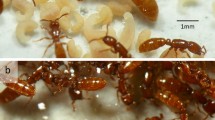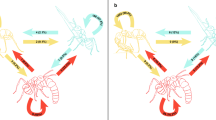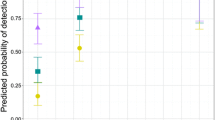Summary
Erebomyrma, a Neotropical genus of pheidologetine ants with caste dimorphism convergent to that ofPheidole, also resemblesPheidole in its pattern of division of labor. The major workers ofE. nevermanni, the species examined during this study, assist in subduing larger prey, defend the nest, and serve as semi-repletes in liquid food storage. Their repertory is limited and specialized when minor workers are present but expands to include foraging and brood care when the minor workers are removed. The expansion is accompanied by a 10X or more increase in general activity rate.
Other details of the natural history and social behavior ofE. nevermanni are given. The most distinctive properties include the occurence of defensive retinues around the queen which intensify when the colony is exposed, the use of trunk trails during foraging, predation on arthropod eggs, and the absence of adult transport during colony emigration.
Zusammenfassung
Erebomyrma, eine neotropische Gattung des Tribus Pheidologetini, hat nicht nur einen mitPheidole konvergenten Kastendimorphismus, sondern gleichtPheidole auch in der Form der Arbeitsteilung. Die Soldaten (major Kaste) vonE. nevermanni, helfen bei der Ueberwältigung von Beute, verteidigen das Nest, und dienen als Speichertier für flüssige Nahrung. Bei Anwesenheit der minor Arbeiterinnen haben sie ein begrenztes und spezialisiertes Verhaltensrepertoire, das jedoch erweitert wird (einschliesslich Nahrungssammeln und Brutpflege), wenn die minor Arbeiterinnen entfernt werden. Gleichlaufend mit dieser Bereicherung des Verhaltensrepertoires erfolgt eine etwa zehnfache Zunahme der allgemeinen Aktivität.
Weitere Einzelheiten zur Biologie und zum Sozialverhalten vonE. nevermanni werden berichtet. Am bemerkenswertesten ist das »Verteidigungs-Gefolge« um die Königin, das verstärkt wird, wenn die Kolonie offen gelegt wird; die Nutzung von Sammelstrassen; das Erbeuten von Arthropoden-Eiern; und das Fehlen von sozialem Trageverhalten unter adulten Ameisen bei Kolonieemigration.
Similar content being viewed by others
References
Brown W.L., 1973. — A comparison of the Hylean and Congo-West African forest ant faunas. In:B.J. Meggers, E.S. Ayensu, andW.D. Duckworth, eds.Tropical Forest Ecosystems in Africa and South America: A Comparative Review, pp. 161–185. Smithsonian Institution Press, Washington, D.C.
Carpenter F.M., 1930. — The fossil ants of North America.Bull. Mus. Comp. Zool. Harv., 70, 1–66, 11 pl.
Eidmann H., 1936. — Oekologisch-faunistische Studien an sudbrasilianischen Ameisen.Arbeit. Phys. Angew. Entomol. Berlin-Dahlem, 3, 26–48, 81–113.
Ettershank G., 1966. — A generic revision of the world Myrmicinae related toSolenopsis andPheidologeton (Hymenoptera: Formicidae).Australian J. Zool., 14, 73–171.
Fagen R.M., Goldman R., 1977. — Behavioural catalogue analysis methodsAnim. Behav., 25, 261–274.
Oster G.F., Wilson E.O., 1978. —Caste and Ecology in the Social Insects. Princeton Univ. Press, Princeton, N.J.
Wheeler W.M., 1914. — The ants of the Baltic amber.Schrift. Physical.-ökon. Ges. Königsberg 55, 1–142.
Wilson E.O., 1962. — The Trinidad cave antErebomyrma (=Spelaeomyrmex) urichi (Wheeler), with a comment on cavernicolous ants in general.Psyche (Cambridge),69, 63–72.
Wilson E.O., 1976. — Behavioral discretization and the number of castes in an ant species.Behav. Ecol. Sociobiol., 1, 141–154.
Wilson E.O., 1984. — The relation between caste ratios and division of labor in the ant genusPheidole (Hymenoptera: Formicidae).Behav. Ecol. Sociobiol., 16, 89–98.
Wilson E.O., 1985a. — Invasion and extinction in the West Indian ant fauna: Evidence from the Dominican amber.Science, 229, 265–267.
Wilson E.O., 1985b. — Ants from the Cretaceous and Eocene amber of North AmericaPsyche (Cambridge),92, 205–216.
Author information
Authors and Affiliations
Rights and permissions
About this article
Cite this article
Wilson, E.O. Caste and division of labor inErebomyrma, a Genus of dimorphic ants (Hymenoptera: Formicidae: Myrmicinae). Ins. Soc 33, 59–69 (1986). https://doi.org/10.1007/BF02224035
Received:
Accepted:
Issue Date:
DOI: https://doi.org/10.1007/BF02224035




